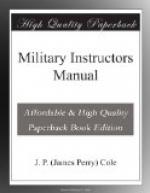It is of the greatest importance that the points before, during, and after firing, should be carefully attended to as otherwise the number of stoppages will be unnecessarily increased.
Nine out of ten stoppages are due to want of care.
Immediate action must become instinctive and automatic.
Grenade Instruction.
INTRODUCTION.—War, as it is being fought on the western front, has brought to light many new weapons; but no other weapon that this struggle has brought forth exceeds the grenade in importance. It is not a new weapon, but its present importance is entirely new. Its extensive use has grown out of conditions on the western front; conditions which have never been seen previous to this war. The fact that armies have taken to “digging themselves in” has necessitated the use of some other weapon than the rifle. The rifle with its flat trajectory is of little use against an enemy who is completely hidden from view and who can go on existing under ground. Hence the reversion to the ancient grenade—but with all its modern improvements. The grenade has shown itself to be the weapon that can solve the problem of seeking out an enemy who is under ground; its trajectory is high and its fire is plunging, so that it can be thrown from a place of concealment and protection and into a place equally well concealed from ordinary view.
The importance of the grenade may be judged from its extensive use by both the Allies and the Germans; and also by the formations now adopted by both British and French armies for the purpose of exploiting its use. In a British Battalion the normal percentage of expert bombers is 25. In the French Company 36 per cent of the men are devoted to grenade work.
A grenade has been defined as a slow moving, high trajectory missile containing high explosive and exploding by contact or time fuse. Grenades may be divided roughly into two classes—1, hand grenades, and 2, rifle grenades, and each of these classes may be subdivided as regards means of explosion, into 1, time fuse, or 2, percussion grenades.
Among the time-fuse hand grenades may be mentioned the Mills No. 5, Stokes bomb, smoke bombs, fumite bombs, etc. The Mills is easily the most important and has come to be the standard adopted by the Allies. The percussion grenade is little used—the most important among those of this type is the so-called “mushroom,” named from its shape.
Chief among the rifle grenades may be mentioned the Mills No. 23, the Hale No. 3 and the Newton No. 24. Just as the Mills hand grenade has become the standard, so has the Mills rifle grenade attained that pre-eminence. A more detailed description of the various sorts of grenades cannot be attempted in this brief space; but one or two diagrams at the close of the chapter may serve to clarify the subject to some extent.
Any course in grenade training should have a three-fold purpose:




